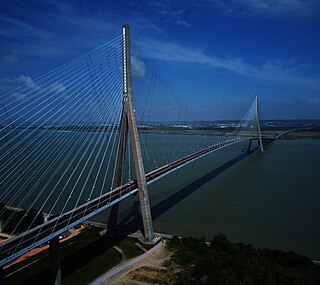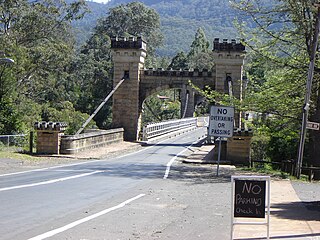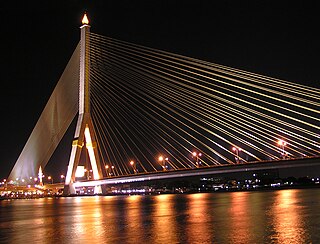
A suspension bridge is a type of bridge in which the deck is hung below suspension cables on vertical suspenders. The first modern examples of this type of bridge were built in the early 1800s. Simple suspension bridges, which lack vertical suspenders, have a long history in many mountainous parts of the world.

A cable-stayed bridge has one or more towers, from which cables support the bridge deck. A distinctive feature are the cables or stays, which run directly from the tower to the deck, normally forming a fan-like pattern or a series of parallel lines. This is in contrast to the modern suspension bridge, where the cables supporting the deck are suspended vertically from the main cable, anchored at both ends of the bridge and running between the towers. The cable-stayed bridge is optimal for spans longer than cantilever bridges and shorter than suspension bridges. This is the range within which cantilever bridges would rapidly grow heavier, and suspension bridge cabling would be more costly.

The Millau Viaduct is a multispan cable-stayed bridge completed in 2004 across the gorge valley of the Tarn near Millau in the Aveyron department in the Occitanie Region, in Southern France. The design team was led by engineer Michel Virlogeux and English architect Norman Foster. As of October 2023, it is the tallest bridge in the world, having a structural height of 343 metres (1,125 ft).

The Rio–Antirrio Bridge, officially the Charilaos Trikoupis Bridge, is one of the world's longest multi-span cable-stayed bridges and longest of the fully suspended type. It crosses the Gulf of Corinth near Patras, linking the town of Rio on the Peloponnese peninsula to Antirrio on mainland Greece by road. It opened one day before the Athens 2004 Summer Olympics, on 12 August 2004, and was used to transport the Olympic flame.

A self-anchored suspension bridge is a suspension bridge type in which the main cables attach to the ends of the deck, rather than directly to the ground or via large anchorages. The design is well-suited for construction atop elevated piers, or in areas of unstable soils where anchorages would be difficult to construct.

A simple suspension bridge is a primitive type of bridge in which the deck of the bridge lies on two parallel load-bearing cables that are anchored at either end. They have no towers or piers. The cables follow a shallow downward catenary arc which moves in response to dynamic loads on the bridge deck.

The Pont de Normandie is a cable-stayed road bridge that spans the river Seine linking Le Havre to Honfleur in Normandy, northern France. Its total length is 2,143.21 metres (7,032 ft) – 856 metres (2,808 ft) between the two piers. It is also the last bridge to cross the Seine before it empties into the ocean. It is a motorway toll bridge with a footpath and a narrow cycle lane in each direction allowing pedestrians and cyclists to cross the bridge free of charge, while motorcycling is also toll-free.

Hampden Bridge is a heritage-listed single-span suspension bridge that carries Moss Vale Road (B73) across the Kangaroo River, in Kangaroo Valley, in the City of Shoalhaven local government area of New South Wales, Australia. The bridge was designed by Ernest de Burgh and built by Loveridge and Hudson. The property is owned by Transport for NSW. It was added to the New South Wales State Heritage Register on 2 August 2019.

An extradosed bridge employs a structure that combines the main elements of both a prestressed box girder bridge and a cable-stayed bridge. The name comes from the word extrados, the exterior or upper curve of an arch, and refers to how the "stay cables" on an extradosed bridge are not considered as such in the design, but are instead treated as external prestressing tendons deviating upward from the deck. In this concept, they remain part of the main bridge superstructure.

The Erasmusbrug is a combined cable-stayed and bascule bridge, construction began in 1986 and was completed in 1996. It crosses the Nieuwe Maas in the centre of Rotterdam, connecting the north and south parts of this city, second largest in the Netherlands. The bridge was named in 1992 after Desiderius Erasmus, a prominent Christian Renaissance humanist also known as Erasmus of Rotterdam. The Erasmus Bridge is Rotterdam's most important landmark and is even part of the city's official logo.
This is an alphabetical list of articles pertaining specifically to structural engineering. For a broad overview of engineering, please see List of engineering topics. For biographies please see List of engineers.

Angers Bridge, also called the Basse-Chaîne Bridge, was a suspension bridge over the Maine River in Angers, France. It was designed by Joseph Chaley and Bordillon, and built between 1836 and 1839. The bridge collapsed on 16 April 1850, while a battalion of French soldiers were marching across it, killing over 200.

The Rama VIII Bridge is a cable-stayed bridge crossing the Chao Phraya River in Bangkok, Thailand. It was built to alleviate traffic congestion on the nearby Phra Pinklao Bridge. Construction of the bridge took place from 1999 to 2002. The bridge was opened on 7 May 2002 and inaugurated on 20 September, the birth anniversary of the late King Ananda Mahidol, after whom it is named. The bridge has an asymmetrical design, with a single pylon in an inverted Y shape on the west bank of the river. Its eighty-four cables are arranged in pairs on the side of the main span and in a single row on the other. The bridge has a main span of 300 metres (980 ft), and was one of the world's largest asymmetrical cable-stayed bridges at the time of its completion.

The Octavio Frias de Oliveira bridge, locally known simply as "Ponte Estaiada", is a cable-stayed bridge over the Pinheiros River in the city of São Paulo, Brazil, opened in May 2008. The iconic bridge has an "X"-shaped tower, 138 metres (453 ft) tall, and connects the west end of Jornalista Roberto Marinho Avenue to the riverside expressway Marginal Pinheiros in the south area of the city. It is named after businessman Octavio Frias de Oliveira.

Vidyasagar Setu, also known as the Second Hooghly Bridge, is a 822.96 meter long cable-stayed 6 laned toll bridge over the Hooghly River in West Bengal, India, linking the cities of Kolkata and Howrah.

The Port à l'Anglais Bridge is a cable-stayed suspension bridge that spans the Seine river between the French communes Alfortville and Vitry-sur-Seine. It carries two lanes of automobile traffic and has pedestrian walkways on each side.

The Sepung Bridge is the first curved, cable-stayed bridge in South Korea. It crosses the Gwangyang western river, a railway and a roadway in South Korea. It was built by Iksan Regional Construction & Management Administration.

The Tirantes Bridge is a cantilever spar cable-stayed bridge that crosses the Lérez River in the city of Pontevedra, Spain, linking the south bank to the north bank at the level of the city's Congress Hall.
The Saint-Just-Saint-Rambert bridge, also known as the "Grand Pont sur la Loire", is a suspension bridge located in the Loire department that spans the Loire at Saint-Just-Saint-Rambert. It facilitates the deviation of the departmental road D 498, which links the A72 autoroute to the west of the town of Bonson.



















